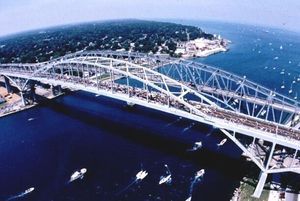Tied-arch Bridge Facts, History and Examples
Tied-arch bridge (also called bowstring-arch or bowstring-girder bridge) is a type of bridge that has an arch rib on each side of the roadway (deck), and one tie beam on each arches, that support deck. Vertical ties connected to the arches support deck from above. It can be considered a bridge between arch bridge and a suspension bridge. They work like arch bridges on one hand, because force of the load on the deck (thrust) is translated as tension to the curved top chord by vertical ties of the deck which try to flatten the arch and to push its tips outward into the abutments. Tips of the arch of this bridge are tied together by a bottom chord. This allows the bridge to be constructed with less robust foundations because force on the abutments is low. Tied-arch bridges can be built on elevated piers or in areas of unstable soil. One more positive attribute of this type of bridge is that it does not depend on horizontal compression forces for its integrity which allows them to be built off-site and then transported into place. But tied-arch bridges are not perfect. They can have poor welds at the connection between the arch rib and the tie girders, and at the connection between the arch and vertical ties. These welds, after some time have to be repaired which is costly, time-consuming and an inconvenience. Construction and design of this bridge is non-redundant which means that if even one of the two tie girders fails the whole structure will collapse without anything to work as safety. As a last problem, tied arch bridges are more expensive to build compared to the other types of bridges of the same length.
Some examples of the tied-arch bridges are:
- The Lowry Avenue Bridge built in 2012 that crosses Mississippi River in Minneapolis, Minnesota. It has 480 m in length and its longest span 137 m. It carries road traffic.
- The Daniel Hoan Memorial Bridge , which was finished in 1977. It spans Milwaukee River in Milwaukee, Wisconsin. It carries road traffic over its length of 3,057.8 m and six lanes.
- The Fort Pitt Bridge was opened in 1959. Its overall length is 368 m while its longest span has 230 m. It was the world's first computer designed tied-arch bridge and the first double-decked tied-arch bridge.

- The Blackfriars Street Bridge in London, Ontario, Canada was finished in 1875. It still carries motor and pedestrian traffic. Its length is 65.8 m.
- Windsor Railway Bridge in Windsor, Berkshire, England was finished in 1849. It was designed by Isambard Kingdom Brunel. It has three bowstring trusses which create two bays for railway tracks and it is the World's oldest wrought iron railway bridge still in regular service.
- The Godavari Arch Bridge over the Godavari River in Rajahmundry, India. It was built in 1997 and its total length is 2,745 m. Its longest span has 97.5 m. Bridge carries railway, namely South Central Railway Line of India and can carry trains that go as fast as 250 km/h.
- Lake Champlain Bridge over the Lake Champlain between Crown Point, New York and Chimney Point, Vermont has 670 m of total length and a longest span of 150 m. It was finished in 2011. It carries road traffic.
- GFRP Lleida Pedestrian Bridge in Leida, Spain spans Madrid-Barcelona high-speed rail link. It was built in only three months and was finished in October 2001. Its total length is 38 m.
- The John McLoughlin Bridge spans the Clackamas River between Oregon City and Gladstone, Oregon, United States. Its total length is 219.5 m and it carries four lanes of Oregon Route 99E.
